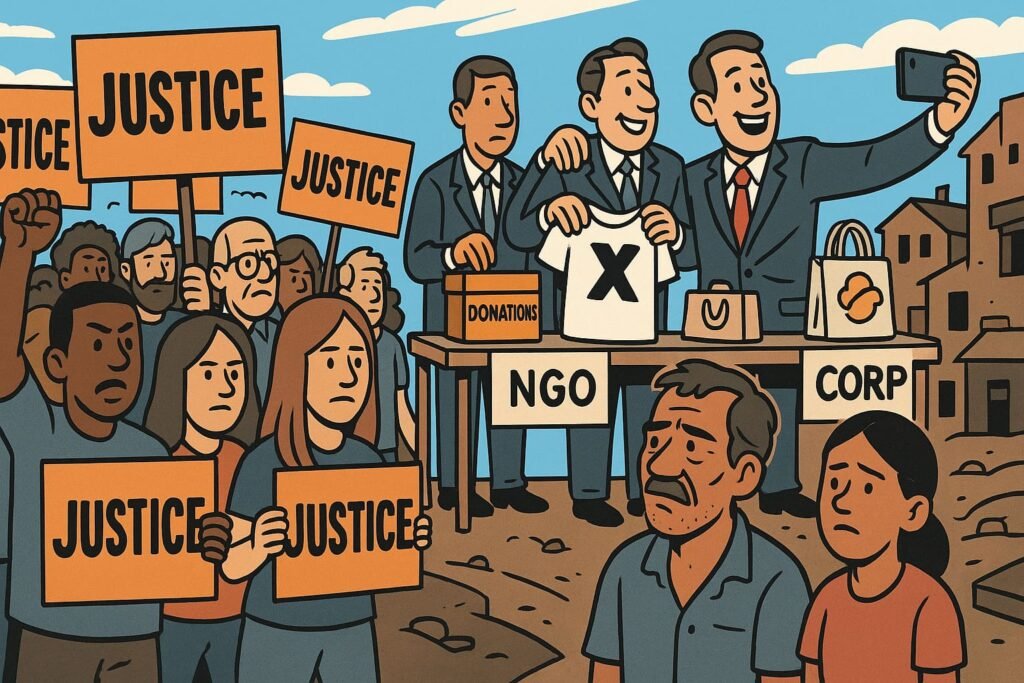BLM Explained – From Justice to Radical Alliances
From Protest to Industry
Black Lives Matter began with a raw demand: stop police brutality, value black lives. No one disputed the principle.
But BLM didn’t stay raw. It turned into an industry.
Hashtags became NGOs. Protests became fundraisers. Slogans became corporate ads. What started with grief and rage ended in branding decks, HR workshops, and real estate portfolios.
BLM shows how modern activism works: justice as product, outrage as renewable energy.
Table of contents
What Is BLM?
In plain English, BLM says:
- Racism is systemic, embedded everywhere — from policing to housing.
- Police killings aren’t accidents but symptoms of structural oppression.
- Justice means radical reform: defund the police, rewrite laws, re-educate society.
- Silence is complicity. Everyone must signal support — or be cast as guilty.
The shift? From civil rights progress to permanent crisis politics.
From Justice to Franchise
What began in Ferguson and peaked with George Floyd became a global brand.
- BLM chapters popped up across the world.
- NGOs cashed in billions in donations.
- Corporations raced to post black squares and “equity pledges.”
- Activists turned into authors, consultants, and media celebrities.
It was no longer protest. It was franchise.
How BLM Shows Up in Practice
BLM didn’t just march — it rewired the culture.
- Politics: Police budgets and new laws reframed in BLM language → Activism & Law
- Corporations: CEOs posting black squares, HR rolling out “anti-racism” training → Corporate Branding
- Education: Schools rewriting lessons around privilege, oppression, equity → Curriculum Changes
- Media: Every disparity framed as systemic racism → Language Battles
BLM turned from protest to operating system.
Buzzwords of BLM
- Systemic Racism → Bias everywhere, invisible but total.
- Defund the Police → Cut cops, fund “community programs.”
- Say Their Names → Martyrs as rallying symbols.
- Silence Is Violence → Neutrality = racism.
These weren’t just slogans. They became moral loyalty tests.
The Money Trail
The 2020 protests triggered one of the biggest fundraising waves in activist history. Donors thought they were funding change. Instead:
- BLM Global Network bought luxury homes.
- Local chapters said they never saw the money.
- Millions vanished into “administration.”
- Activists built careers — speaking tours, books, consultancy gigs.
Outrage paid — but not for the communities it claimed to help.
Who Benefited? Who Didn’t?
Winners:
- Activists → salaries, careers, prestige.
- Corporations → cheap moral cover; slogans instead of wage rises.
- Politicians → harnessed outrage, then moved on.
Losers:
- The communities still living with crime, broken schools, collapsing housing.
The Consequences of BLM Thinking
- Permanent Crisis → racism cast as unsolvable, so the machine never runs out of fuel.
- Division → people boxed into skin-colour categories.
- Silenced Debate → doubt BLM and you’re branded racist.
- Distraction → focus on slogans while inequality deepens.
Ironically, a movement for justice ended up empowering elites more than the poor.
Why It Matters
BLM is the template for modern activism:
- Outrage sparks.
- Institutions amplify.
- Money floods in.
- The cause becomes a business model.
It’s not just about policing anymore. BLM became the blueprint for today’s woke politics.
Conclusion: Rage as Renewable Energy
BLM began with a cry for justice. It ended as a franchise.
The poor communities still wait for safety, schools, jobs. But outrage? Outrage keeps paying.
Quick Timeline of BLM
- 2013: Founded after the Trayvon Martin case.
- 2014: Ferguson protests put BLM on the map.
- 2020: George Floyd’s death → global peak, billions raised.
- 2021: Luxury homes scandal, missing funds.
- Now: The slogan thrives. The industry thrives. The problems remain.
👉 Want the bigger picture? Explore our full Activism Explainer Hub to see how movements, tactics, and ideologies shape modern politics.
FAQ: Black Lives Matter
What is Black Lives Matter?
A protest movement against police brutality that grew into a global NGO and brand.
Why is BLM controversial?
Because it mixes real issues with radical ideology, fuels division, and often benefits elites more than communities.
How did corporations respond?
By posting slogans, pledging donations, and rolling out HR training — symbolism instead of real fixes.
What’s the danger of BLM?
It entrenches division and turns activism into a permanent business model.
What’s the irony?
A movement born from justice ended up as an industry of outrage.



